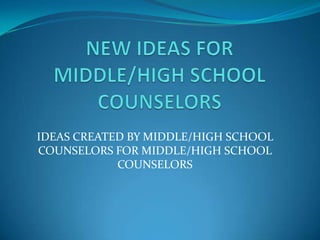
Ideas for middle school counselors
- 1. IDEAS CREATED BY MIDDLE/HIGH SCHOOL COUNSELORS FOR MIDDLE/HIGH SCHOOL COUNSELORS
- 3. Does My School Need A Program Specifically For Girls? If you’re addressing some of the following issues in your student body, this program may be right for your school: • Helping girls learn to form and maintain positive friendships • Addressing negative girl groups that form at lunchtime or at recess • Changing the climate of a grade level with negative girl ringleaders • Bullying, cyber-bullying, or harassment • Addressing rumors and name-calling among female students • Counseling girls who have poor body images or low self-esteem • Teaching such leadership skills as public speaking or career exploration • Helping students respond positively to peer pressure
- 5. SKILL 2: DEFINING SELF Goal: Group members participate in discussion to learn about positive character traits and determine their own personal strengths. ICEBREAKER Begin with this icebreaker, which requires students to think about personal character traits: Adjective Name Game: Divide students into groups of approximately 10 members. Each group sits in a circle. Each group member thinks of an adjective that describes her and begins with the same letter as her first name. One person says her adjective and name, and each subsequent person says her adjective and name and those of all the group members who have gone before her.
- 6. SKILL 1: QUALITIES OF A LEADER Goal: Through group discussion, members will explore leadership qualities in order to determine the characteristics of a positive leader. ICEBREAKER This icebreaker, requires students to work cooperatively: The Human Knot: Form circles of 5–10 students. Each girl places her right arm into the circle and reaches across and holds another student’s hand. Then each student extends her left arm into the circle and holds a different student’s left hand. At this point, each student should be holding a hand of two different students. Explain that they have formed a human knot and must work together to untangle themselves without anyone letting go. Observe as students discuss how to solve the problem and give directions to one another as they work to untangle their knot. Ask students what they saw, heard, or felt that indicated that someone was demonstrating good leadership skills.
- 7. SKILL 1: ESTABLISHING GROUP NORMS Goal: Through group discussion, students and coordinators will review expectations and establish program norms and rules. ICEBREAKER This icebreaker, allows each student to share information about herself: You Think You Know Me: Students sit in a circle. As a personal introduction, each student completes the following sentences: My name is ______________________________________ . You may know that I_______________________________. You probably didn’t know that I_____________________ .
- 10. Keeping Yourself On Track
- 11. Define the Group’s Purpose
- 13. Beginnings—Giving the group a chance to know one another
- 14. Beginnings—Working together establishes a sense of unity
- 15. Middles—Group consensus is common and differences of opinion are more easily solved
- 16. Middles—Relationships between the leader and other group members are at their strongest
- 17. Endings: Closing the group on a positive note.
- 19. The 10-Session Program Section 1: Begin the Group/Ready, Set Go! Section 2: Understanding Anger Anger Triggers & The Origin of Anger Section 3: Communicating Anger Communication Skills & Working Through Anger Section 4: Expressing Anger/Resolving Conflict Section 6: Thinking About Anger Toxic Thinking & Needs and Wants Section 7: Skills & Techniques For Coping With Anger Transforming Anger Section 8: Closing the Group/The Grande Finale
- 20. Understanding Anger Anger Triggers The Origin of Anger
- 21. Communicating Anger Communication Skills Working Through Anger
- 22. Expressing Anger Resolving Conflict
- 23. Thinking About Anger Toxic Thinking Needs And Wants
- 24. Skills & Techniques For Coping With Anger Transforming Anger
- 25. Other Great Middle School Books
